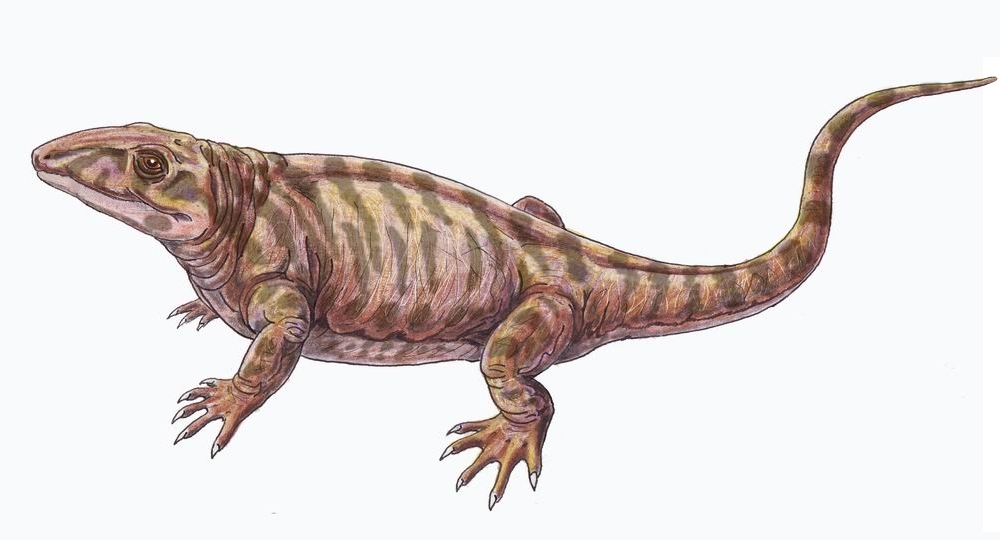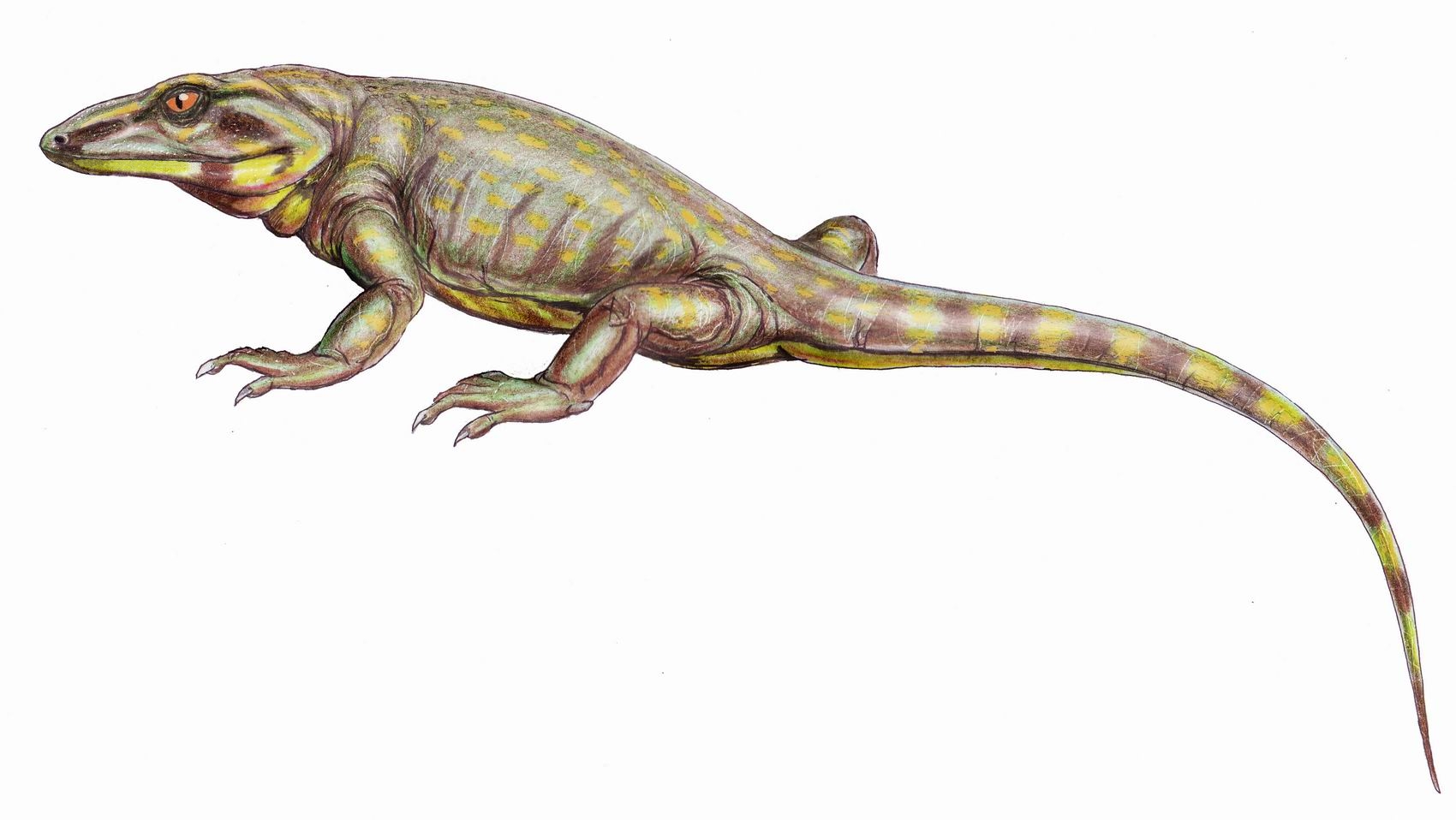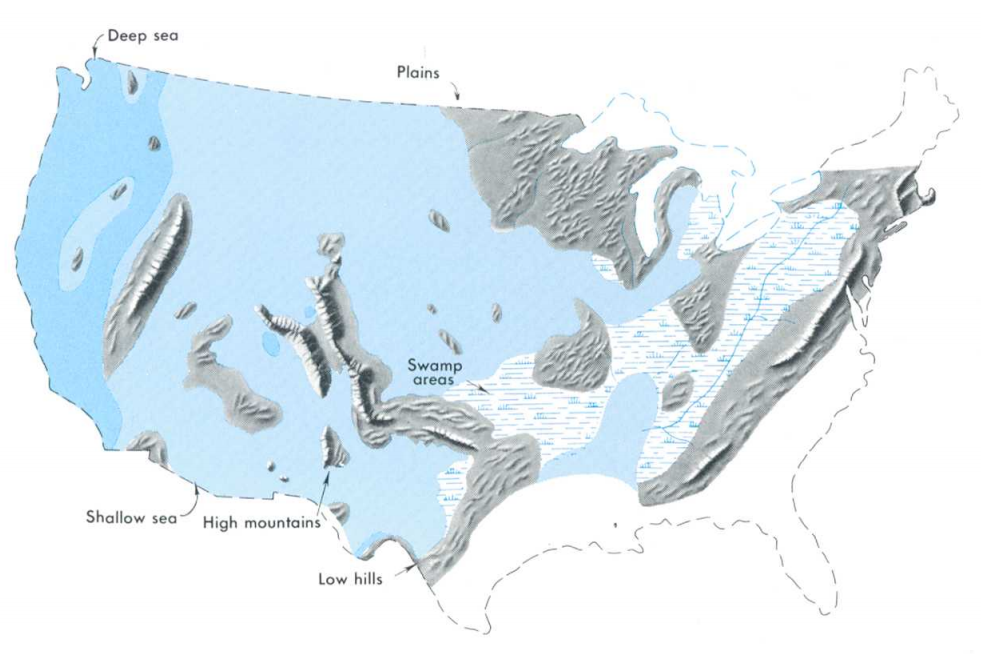|
Archaeovenator
''Archaeovenator'' is an extinct genus of Late Carboniferous varanopid synapsids known from Greenwood County, Kansas of the United States. It was first named by Robert R. Reisz and David W. Dilkes in 2003 and the type species is ''Archaeovenator hamiltonensis''. ''Archaeovenator hamiltonensis'' is known from the holotype KUVP 12483, a three-dimensionally preserved, nearly complete and articulated skeleton, including the skull, with limbs and girdles slightly separated from postcranial skeleton. It was collected in the Hamilton Quarry, from the Calhouns Shale Formation of the Shawnee Group, dating to the Virgilian stage (or alternatively late Kasimovian to early Gzhelian stage) of the Late Pennsylvanian Series, about 300 million years ago. The generic name is derived from the Latin ''Archaeo'' and ''venator'', meaning "ancient hunter". The specific name is named after its finding place Hamilton Quarry Hamilton Quarry is a Late Carboniferous lagerstätte near Hamilton, Ka ... [...More Info...] [...Related Items...] OR: [Wikipedia] [Google] [Baidu] |
Varanopidae
Varanopidae is an extinct family (biology), family of amniotes known from the Late Carboniferous to Middle Permian that resembled monitor lizards (with the name of the group deriving from the monitor lizard genus ''Varanus'') and may have filled a similar niche. Typically, they are considered to be relatively Basal (phylogenetics), basal Synapsida, synapsids (and thus more closely related to mammals than to reptiles), although some studies from the late 2010s recovered them being taxonomically closer to diapsid reptiles, recent studies from the early 2020s support their traditional placement as synapsids on the basis of high degree of bone labyrinth ossification, maxillary canal morphology and phylogenetic analyses. A varanopid from the late Middle Permian Pristerognathus Assemblage Zone, ''Pristerognathus'' Assemblage Zone (Capitanian) is the youngest known varanopid and the last member of the "pelycosaur" group of synapsids. Thus, Varanopidae vanishes from the fossil record at th ... [...More Info...] [...Related Items...] OR: [Wikipedia] [Google] [Baidu] |
Dendromaia
''Dendromaia'' is an extinct genus of varanopid from the Carboniferous of Nova Scotia. It contains a single species, ''Dendromaia unamakiensis''. ''Dendromaia'' is the oldest known varanopid and the only one found in Nova Scotia. Known from a large partial skeleton preserved with its tail wrapped around a much smaller partial skeleton, ''Dendromaia'' may also represent the oldest known occurrence of parental care in the fossil record. While the larger skeleton possessed certain mycterosaurine-like features, the smaller skeleton resembled basal varanopids such as ''Archaeovenator'' and ''Pyozia'', creating uncertainty over whether characteristics at the base of Varanopidae have legitimate phylogenetic significance or instead reflect the immaturity of basal varanopid specimens. Discovery ''Dendromaia unamakiensis'' is known from a slab and counterslab containing two skeletons. The specimen, NSM017GF020.001, was discovered in a petrified lycopod stump at Point Aconi on Cape Breton ... [...More Info...] [...Related Items...] OR: [Wikipedia] [Google] [Baidu] |
Varanopid
Varanopidae is an extinct family of amniotes known from the Late Carboniferous to Middle Permian that resembled monitor lizards (with the name of the group deriving from the monitor lizard genus ''Varanus'') and may have filled a similar niche. Typically, they are considered to be relatively basal synapsids (and thus more closely related to mammals than to reptiles), although some studies from the late 2010s recovered them being taxonomically closer to diapsid reptiles, recent studies from the early 2020s support their traditional placement as synapsids on the basis of high degree of bone labyrinth ossification, maxillary canal morphology and phylogenetic analyses. A varanopid from the late Middle Permian ''Pristerognathus'' Assemblage Zone (Capitanian) is the youngest known varanopid and the last member of the "pelycosaur" group of synapsids. Thus, Varanopidae vanishes from the fossil record at the same time as dinocephalians, plausibly as a result of a major mass extinction eve ... [...More Info...] [...Related Items...] OR: [Wikipedia] [Google] [Baidu] |
2003 In Paleontology
Plants Conifers Angiosperms Gnetophytes Fungi Arthropods Arachnids Insects Conodont paleozoology German paleontologist and stratigraphy, stratigrapher Heinz Walter Kozur (1942-2013) described the conodont genus ''Carnepigondolella''. Vertebrate paleozoology Parareptiles Non-avian dinosaurs Data courtesy of George Olshevsky's dinosaur genera list. Newly named birds Plesiosaurs Pterosaurs Synapsids Non-mammalian Mammals References {{portal, Paleontology [...More Info...] [...Related Items...] OR: [Wikipedia] [Google] [Baidu] |
Hamilton Quarry
Hamilton Quarry is a Late Carboniferous lagerstätte near Hamilton, Kansas, United States. It has a diverse assemblage of unusually well-preserved marine, euryhaline, freshwater, flying, and terrestrial fossils (invertebrates, vertebrates, and plants). The habitat of some of these faunal elements, as for anamniotic stegocephalians, is debated; although some of these have traditionally been interpreted as freshwater inhabitants, some may have been euryhaline. This extraordinary mix of fossils suggests it was once an estuary. This type of Lagerstätte is considered a ''Konservat-Lagerstätte'' (or ''conservation lagerstätte''), due to the quality the preservation of soft tissue (skin preservation). The lagerstätte occurs within a paleovalley that was incised into the surrounding Carboniferous cyclothemic sequence during a time of low sea level and was then filled in during a subsequent transgression. The channel has a capping series of interbedded laminated limestones and mudston ... [...More Info...] [...Related Items...] OR: [Wikipedia] [Google] [Baidu] |
Synapsid
Synapsida is a diverse group of tetrapod vertebrates that includes all mammals and their extinct relatives. It is one of the two major clades of the group Amniota, the other being the more diverse group Sauropsida (which includes all extant reptiles and therefore, birds). Unlike other amniotes, synapsids have a single temporal fenestra, an opening low in the skull roof behind each eye socket, leaving a zygomatic arch, bony arch beneath each; this accounts for the name "synapsid". The distinctive temporal fenestra developed about 318 million years ago during the Late Carboniferous period, when synapsids and sauropsids diverged, but was subsequently merged with the orbit in early mammals. The basal (phylogenetics), basal amniotes (reptiliomorphs) from which synapsids evolved were historically simply called "reptiles". Therefore, stem group synapsids were then described as mammal-like reptiles in classical systematics, and non-therapsid synapsids were also referred to as pelyco ... [...More Info...] [...Related Items...] OR: [Wikipedia] [Google] [Baidu] |
Pennsylvanian (geology)
The Pennsylvanian ( , also known as Upper Carboniferous or Late Carboniferous) is, on the International Commission on Stratigraphy, ICS geologic timescale, the younger of two period (geology), subperiods of the Carboniferous Period (or the upper of two system (stratigraphy), subsystems of the Carboniferous System). It lasted from roughly . As with most other geochronology, geochronologic units, the stratum, rock beds that define the Pennsylvanian are well identified, but the exact date of the start and end are uncertain by a few hundred thousand years. The Pennsylvanian is named after the U.S. state of Pennsylvania, where the coal Bed (geology), beds of this age are widespread. The division between Pennsylvanian and Mississippian (geology), Mississippian comes from North American stratigraphy. In North America, where the early Carboniferous beds are primarily marine limestones, the Pennsylvanian was in the past treated as a full-fledged geologic period between the Mississippian ... [...More Info...] [...Related Items...] OR: [Wikipedia] [Google] [Baidu] |
Calhouns Shale Formation
The Calhouns Shale is a geologic formation in Kansas. It preserves fossils. See also * List of fossiliferous stratigraphic units in Kansas * Paleontology in Kansas Paleontology in Kansas refers to paleontological research occurring within or conducted by people from the United States, U.S. state of Kansas. Kansas has been the source of some of the most spectacular fossil discoveries in US history. The fossil ... References * Carboniferous Kansas Shale formations of the United States {{Carboniferous-stub ... [...More Info...] [...Related Items...] OR: [Wikipedia] [Google] [Baidu] |
Kasimovian
The Kasimovian is a geochronologic age or chronostratigraphic stage in the ICS geologic timescale. It is the third stage in the Pennsylvanian (late Carboniferous), lasting from to Ma.; 2004: ''A Geologic Time Scale 2004'', Cambridge University Press. The Kasimovian Stage follows the Moscovian and is followed by the Gzhelian. The Kasimovian saw an extinction event which occurred around 305 mya, referred to as the Carboniferous Rainforest Collapse. It roughly corresponds to the Missourian in North American geochronology and the Stephanian in western European geochronology. Name and definition The Kasimovian is named after the Russian city of Kasimov. The stage was split from the Moscovian in 1926 by Boris Dan'shin (1891-1941), who gave it the name ''Teguliferina horizon''. The name was posthumously changed to ''Kasimov horizon'' by Dan'shin in 1947. The name Kasimovian was introduced by Georgy Teodorovich in 1949. The base of the Kasimovian Stage is at the base of the ... [...More Info...] [...Related Items...] OR: [Wikipedia] [Google] [Baidu] |
Gzhelian
The Gzhelian ( ) is an age in the ICS geologic time scale or a stage in the stratigraphic column. It is the youngest stage of the Pennsylvanian, the youngest subsystem of the Carboniferous. The Gzhelian lasted from to Ma. It follows the Kasimovian age/stage and is followed by the Asselian age/stage, the oldest subdivision of the Permian system. The Gzhelian is more or less coeval with the Stephanian Stage of the regional stratigraphy of Europe. Name and definition The Gzhelian is named after the Russian village of Gzhel (), nearby Ramenskoye, not far from Moscow. The name and type locality were defined by Sergei Nikitin (1851–1909) in 1890. The base of the Gzhelian is at the first appearance of the Fusulinida genera '' Daixina'', '' Jigulites'' and '' Rugosofusulina'', or at the first appearance of the conodont ''Streptognathodus zethus''. The top of the stage (the base of the Permian system) is at the first appearance of the conodont ''Streptognathodus isolat ... [...More Info...] [...Related Items...] OR: [Wikipedia] [Google] [Baidu] |
Late Carboniferous
Late or LATE may refer to: Everyday usage * Tardy, or late, not being on time * Late (or the late) may refer to a person who is dead Music * Late (The 77s album), ''Late'' (The 77s album), 2000 * Late (Alvin Batiste album), 1993 * Late!, a pseudonym used by Dave Grohl on his ''Pocketwatch (album), Pocketwatch'' album * Late (rapper), an underground rapper from Wolverhampton * "Late", a song by Kanye West from ''Late Registration'' Other uses * Late (Tonga), an uninhabited volcanic island southwest of Vavau in the kingdom of Tonga * Late (The Handmaid's Tale), "Late" (''The Handmaid's Tale''), a television episode * LaTe, Laivateollisuus, Oy Laivateollisuus Ab, a defunct shipbuilding company * Limbic-predominant age-related TDP-43 encephalopathy, a proposed form of dementia * Local-authority trading enterprise, a New Zealand business law * Local average treatment effect, a concept in econometrics * Late, a synonym for ''cooler'' in Stellar classification#"Early" and "late" nomencla ... [...More Info...] [...Related Items...] OR: [Wikipedia] [Google] [Baidu] |
Series (stratigraphy)
Series are subdivisions of rock layers based on the age of the rock and formally defined by international conventions of the geological timescale. A series is therefore a sequence of strata defining a chronostratigraphic unit. Series are subdivisions of systems and are themselves divided into stages. Series is a term defining a unit of rock layers formed during a certain interval of time (a chronostratigraphic unit); it is equivalent (but not synonymous) to the term ''geological epoch'' (see epoch criteria) which defines the interval of time itself, although the two words are sometimes confused in informal literature. Series in the geological timescale The geological timescale has all systems in the Phanerozoic eonothem subdivided into series. Some of these have their own names; in other cases a system is simply divided into a Lower, Middle and Upper series, with official series being capitalized and unofficial designations (such as "middle Cretaceous") being left uncapital ... [...More Info...] [...Related Items...] OR: [Wikipedia] [Google] [Baidu] |






